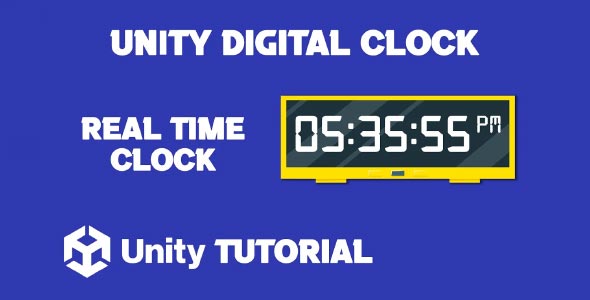This Unity Digital Clock tutorial will guide you through creating a functional, accurate digital clock that can display system time directly within your game interface. Whether you’re building a simulation, productivity app, or a time-based puzzle game, a real-time clock adds immersion and utility to the user experience. Adding a real-time digital clock to your Unity project can be useful for a variety of game types and applications.
Creating a digital clock in Unity is surprisingly simple thanks to Unity’s powerful scripting environment and flexible UI system. With just a few components and a small amount of code, you can display the current time in hours, minutes, and seconds, and even format it in different ways depending on your game’s design.
Unity Real Clock
To implement a Unity real clock, you’ll begin by setting up the UI elements. Using Unity’s Canvas system, create a Text (or TextMeshPro) object where the clock will be displayed. Position it wherever it fits best in your game interface—usually in the corner of the screen for utility purposes or centrally if it’s part of the core gameplay.
Next, you’ll use Unity’s System.DateTime class to fetch the actual time from the user’s device. This ensures that the time displayed is accurate to the local system and doesn’t rely on in-game time progression. This is especially useful for games or apps that require real-world time, such as idle games, real-time simulations, or daily challenges.
Once the time is fetched, you’ll update the clock display continuously—usually once per second. This can be done using a coroutine or by updating it in the Update() method with a timer to avoid unnecessary performance overhead. The time can be formatted in 12-hour or 24-hour formats using standard .NET time formatting strings.
Unity Clock System Tutorial
Building a robust Unity clock system also means handling time zones, daylight saving time, and possibly syncing with network time if high accuracy is needed. While local system time is usually sufficient, developers creating multiplayer or globally coordinated apps might want to pull time from an API or use a server-based time reference.
Additionally, you might want to integrate alarms, countdowns, or reminders based on this clock system. This adds layers of functionality and can make your game more interactive. For example, you could unlock special rewards at specific times or have in-game events triggered by real-world clocks.
Another use case for a Unity real clock is to create a sense of continuity between the real world and the game world. Many mobile games use real clocks to lock or unlock features at certain times of the day. Others track play sessions and reward users for returning after specific time intervals. By tying your in-game events to real-time, you can create engagement loops that keep users coming back daily.
Styling your digital clock to match your game’s theme is just as important as functionality. With Unity’s UI tools, you can customize fonts, colors, animations, and transitions to give the clock a polished, integrated look. For sci-fi games, a glowing digital font might fit, while in a medieval-themed game, a more rustic clock appearance could be appropriate.
You can also enhance the display with visual effects like fading, blinking colons, or even analog-style ticking sound effects to give it a realistic feel. These small touches can dramatically improve user immersion and make the feature feel like a core part of the experience rather than just a utility.
Conclusion
In conclusion, this Unity Digital Clock tutorial gives you everything you need to implement a real-time, visually appealing clock into your project. From UI setup and system time integration to formatting and stylizing, each step helps enhance your app or game’s functionality.
Adding a digital clock is not just a visual feature—it can drive gameplay mechanics, support real-time events, and provide users with a stronger connection to your app. Whether you’re designing a productivity tool, a role-playing game, or a casual mobile app, a digital clock is a versatile and simple addition that can significantly elevate the user experience.
By following this tutorial, you’ll be able to create a dynamic, Unity clock system that fits seamlessly into any project, giving your game a professional, polished edge.
Script: DigitalClock.cs
using System.Collections;
using System.Collections.Generic;
using UnityEngine;
using UnityEngine.UI;
public class DigitalClock : MonoBehaviour
{
public Text clockText;
// Start is called before the first frame update
void Start()
{
StartCoroutine(UpdateClock());
}
IEnumerator UpdateClock()
{
while (true)
{
System.DateTime now = System.DateTime.Now;
clockText.text = now.ToString("hh:mm:ss tt");
yield return new WaitForSeconds(1);
}
}
}Creating a digital clock in Unity is a great way to display the current time within your game or app. If you also need a countdown feature, such as for timed challenges or limited events, this Unity Countdown Clock Tutorial provides a clear and practical guide to help you build a countdown timer that fits seamlessly into your project.


